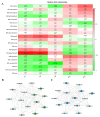Uncovering the molecular mechanisms of Acer fabri in adjusting to low-temperature stress through integrated physiological and transcriptomic analysis
- PMID: 39856103
- PMCID: PMC11760354
- DOI: 10.1038/s41598-025-86328-w
Uncovering the molecular mechanisms of Acer fabri in adjusting to low-temperature stress through integrated physiological and transcriptomic analysis
Abstract
Acer fabri is an excellent color-leaf tree species, with high ornamental value. Low temperatures are known to limit the growth and geographical distribution of A. fabri. The molecular mechanism of A. fabri in response to low-temperature stress was rarely reported. To understand the molecular mechanism of A. fabri in response to low-temperature stress, relevant physiological changes were identified and the transcriptome sequencing was conducted under different stress durations. The results showed that the proline, the soluble sugar (SS) and the soluble protein (SP) content increased in A. fabri leaves under low-temperature stress, while the peroxidase (POD) and activating superoxide dismutase (SOD) activity increased first and then decreased. It was also found by the OPLS-DA analysis that SOD is the most important physiological indicator of A. fabri in response to low-temperature stress. By transcriptome sequencing, a total of 56,732 genes were identified, including 832 transcription factors (TFs). Differentially expressed genes (DEGs) were significantly enriched in metabolic pathways, phytohormone signaling, and plant mitogen-activated protein kinase (MAPK) signaling pathways. Moreover, the analysis of gene co-expression networks, specifically weighted gene co-expression network analysis (WGCNA), indicates that Af0048792 and Af0026061 could be significant in the response to stress from low temperatures. Furthermore, it was observed that NAC (Af0033429) and MIKC (Af0004917) might have interactions with Af0048792, and MIKC (Af0004917) may additionally interact with Af0026061. These findings could enhance our understanding of the molecular mechanisms of A. fabri in response to low-temperature stress.
Keywords: Acer Fabri; Low-temperature stress; Transcriptome analysis; WGCNA.
© 2025. The Author(s).
Conflict of interest statement
Declarations. Competing interests: The authors declare no competing interests.
Figures








Similar articles
-
Genome-wide identification and functional analysis of R2R3-MYB genes in Acer pseudosieboldianum: insights into low temperature stress response and anthocyanin biosynthesis.BMC Plant Biol. 2025 Jul 2;25(1):795. doi: 10.1186/s12870-025-06782-6. BMC Plant Biol. 2025. PMID: 40596834 Free PMC article.
-
Identification of key modules and genes in response to high-temperature stress in Platostoma palustre based on WGCNA.BMC Plant Biol. 2025 May 24;25(1):695. doi: 10.1186/s12870-025-06686-5. BMC Plant Biol. 2025. PMID: 40419951 Free PMC article.
-
Genome-wide and transcriptome analysis of PdWRKY transcription factors in date palm (Phoenix dactylifera) revealing insights into heat and drought stress tolerance.BMC Genomics. 2025 Jul 1;26(1):589. doi: 10.1186/s12864-025-11715-6. BMC Genomics. 2025. PMID: 40597593 Free PMC article.
-
Home treatment for mental health problems: a systematic review.Health Technol Assess. 2001;5(15):1-139. doi: 10.3310/hta5150. Health Technol Assess. 2001. PMID: 11532236
-
Systemic pharmacological treatments for chronic plaque psoriasis: a network meta-analysis.Cochrane Database Syst Rev. 2021 Apr 19;4(4):CD011535. doi: 10.1002/14651858.CD011535.pub4. Cochrane Database Syst Rev. 2021. Update in: Cochrane Database Syst Rev. 2022 May 23;5:CD011535. doi: 10.1002/14651858.CD011535.pub5. PMID: 33871055 Free PMC article. Updated.
References
-
- Ding, Y. L., Shi, Y. T. & Yang, S. H. Advances and challenges in uncovering cold tolerance regulatory mechanisms in plants. New Phytologist222, 1690–1704 (2019). - PubMed
-
- Guo, X., Liu, D. & Chong, K. Cold signaling in plants: Insights into mechanisms and regulation. J. Integrative Plant Biol.60, 745–756 (2018). - PubMed
-
- Agurla, S., Gahir, S., Munemasa, S., Murata, Y. & Raghavendra, A. S. Mechanism of stomatal closure in plants exposed to drought and low-temperature stress. Adv. Exp. Med. Biol.10, 978–981 (2018). - PubMed
-
- Nguyen, H. C. et al. Special trends in CBF and DREB2 groups in Eucalyptus gunnii vs Eucalyptus grandis suggest that CBF are master players in the trade-off between growth and stress resistance. Physiologia Plantarum159(4), 445–467 (2017). - PubMed
MeSH terms
Substances
Grants and funding
LinkOut - more resources
Full Text Sources

